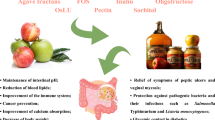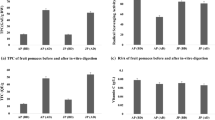Abstract
Proanthocyanidins (PAs) in apples are condensed tannins comprised mostly of (−)-epicatechin units with some terminal (+)-catechins. PAs, especially those having a long chain-length, are absorbed in the upper intestine only to a small extent and are passed to the colon. In the colon they are subjected to microbial metabolism by colonic microbiota. In the present article, the ability of human microbiota to ferment apple PAs is studied. Freeze-dried fruit preparations (apple, enzymatically digested apple, isolated cell-walls, isolated PAs or ciders) from two varieties, Marie Ménard and Avrolles, containing PAs of different chain lengths, were compared. Fermentation studies were performed in an in vitro colon model using human faecal microbiota as an inoculum. The maximal extent of conversion to known microbial metabolites, was observed at late time point for Marie Ménard cider, having short PAs. In this case, the initial dose also contributed to the extent of conversion. Long-chain PAs were able to inhibit the in vitro microbial metabolism of PAs shown as low maxima at early time points. Presence of isolated PAs also suppressed SCFA formation from carbohydrates as compared with that from apple cell wall or faecal suspension without substrates. The low maximal extents at early time points suggest that there is a competition between the inhibitory effect of the PAs on microbial activity, and the ability to convert PAs by the microbiota.





Similar content being viewed by others
References
Abia R, Fry SC (2001) Degradation and metabolism of 14C-labeled proanthocyanidins from carob (Ceratonia siliqua) pods in the gastrointestinal tract of the rat. J Sci Food Agric 81:1156–1165
Aprikian O, Duclos V, Guyot S, Besson C (2003) Apple pectin and a polyphenol-rich apple concentrate are more effective together than separately on cecal fermentations and plasma lipids in rats. J Nutr 133:1860–1865
Auger C, Al-Awwadi N, Bornet A, Rouanet J-M, Gasc F, Cros G, Teissedre P-L (2004) Catechins and procyanidins in Mediterranean diets. Food Res Intern 37:233–245
Aura A-M, Härkönen H, Fabritius M, Poutanen K (1999) Development of an in vitro digestion method for removal of starch and protein and assessment of its performance using rye and wheat breads. J Cereal Sci 29:139–152
Aura A-M, O’Leary KA, Williamson G, Ojala M, Bailey M, Puupponen-Pimiä R, Nuutila AM, Oksman-Caldentey K-M, Poutanen K (2002) Quercetin derivatives are conjugated and converted to hydroxyphenylacetic acid but not methylated by human fecal flora in vitro. J Agric Food Chem 50:1725–1730
Aura A-M, Karppinen S, Virtanen H, Forssell P, Heinonen S-M, Nurmi T, Adlercreutz H, Poutanen K (2005) Processing of rye bran influences both the fermentation of dietary fibre and the bioconversion of lignans by human faecal flora in vitro. J Sci Food Agric 85:2085–2093
Aura A-M, Mattila I, Seppänen-Laakso T, Miettinen J, Oksman-Caldentey K-M, Oresic M (2008) Microbial metabolism of catechin stereoisomers by human faecal microbiota: comparison of targeted analysis and a non-targeted metabolomics method. Phytochem Lett 1:18–22
Barry JL, Hoebler C, Macfarlane GT, Macfarlane S, Mathers JC, Reed KA, Mortensen PB, Norgaard I, Rowland IR, Rumney CJ (1995) Estimation of the fermentability of dietary fibre in vitro: a European interlaboratory study. Br J Nutr 74:303–322
Blumenkrantz N, Asboe-Hansen G (1973) New method for quantitative determination of uronic acids. Anal Biochem 54:484–489
Cerda B, Tomas-Barberan FA, Espin JC (2005) Metabolism of antioxidant and chemopreventive ellagitannins from strawberries, raspberries, walnuts, and oak-aged wine in humans: identification of biomarkers and individual variability. J Agric Food Chem 53:227–235
Cheynier V, Prieur C, Guyot S, Rigaud J, Moutounet M (1997) The structures of tannins in grapes and wines and their interactions with proteins. In: Watkins T (ed) Wine; nutritional and therapeutic benefits. ACS Symp Series 661:81–93
Deprez S, Brezillon C, Rabot S, Philippe C, Mila I, Lapierre C, Scalbert A (2000) Polymeric proanthocyanidins are catabolized by human colonic microflora into low-molecular-weight phenolic acids. J Nutr 130:2733–2738
Englyst HN, Cummings JH (1984) Simplified method for the measurement of total non-starch polysaccharides by gas-liquid chromatography of constituent sugars as alditol acetates. Analyst 109:937–942
Gonthier M-P, Donovan JL, Texier O, Felgines C, Remesy C, Scalbert A (2003) Metabolism of dietary procyanidins in rats. Free Radical Bio Biochem 35:837–844
Gonthier M-P, Remesy C, Scalbert A, Cheynier V, Souquet J-M, Poutanen K, Aura A-M (2006) Microbial metabolism of caffeic acid and its esters chlorogenic and caftaric acids by human faecal microbiota in vitro. Biomed Pharmacother 60:536–540
Guyot S, Marnet N, Sanoner P, Drilleau J-F (2001) Direct thiolysis on crude apple materials for high-performance liquid chromatography characterization and quantification of polyphenols in cider apple tissues and juices. In: Packer L (ed) Methods in enzymology—flavonoïds and other polyphenols. Academic Press, New York 335:57–70
Guyot S, Marnet N, Drilleau JF (2001) Thiolysis-HPLC characterization of apple procyanidins covering a large range of polymerization states. J Agric Food Chem 49:2085–2093
Guyot S, Le Bourvellec C, Marnet N, Drilleau JF (2002) Procyanidins are the most abundant polyphenols in dessert apples at maturity. Lebensm U-Wiss Technol 35:289–291
Guyton AC, Hall JE (1996) Transport and mixing of food in the alimentary tract. In: Textbook of medical physiology, 9th edn. W.B. Saunders Company, Philadelphia pp 803–813
Hammerstone JF, Lazarus SA, Schmitz HH (2000) Procyanidin content and variation in some commonly consumed foods. J Nutr 130:2086S–2092S
Holt RR, Lazarus SA, Sullards MC, Zhu QY, Schramm DD, Hammerstone JF, Fraga CG, Schmitz HH, Keen CL (2002) Procyanidin dimer B2 [epicatechin-(4B-8)-epicatechin] in human plasma after consumption of a flavanol-rich cocoa. Am J Clin Nutr 76:798–804
Hubert B, Baron A, Le Queré J-M, Renard CMGC (2007) Influence of prefermentary clarification on the composition of apple musts. J Agric Food Chem 55:5118–5122
Johnson IT (2002) Anticarcinogenic effects of diet-related apoptosis in the colorectal mucosa. Food Chem Toxicol 40:1171–1178
Lafay S, Gil-Izquierdo A (2008) Bioavailability of phenolic acids. Phytochem Rev 7:301–311
Le Bourvellec C, Le Quéré J-M, Renard CMGC (2007) Impact of non-covalent interactions between condensed tannin and apple cell-walls: elaboration of a quantitative model and its application to transfer from fruit to juice. J Agric Food Chem 55:7896–7904
Lea AGH (1978) The analysis of cider phenolics. Ann Nutr Alim 32:1051–1061
Levrat M-A, Texier MDO, Régerat F, Demingé C, Rémésy C (1993) Comparison of the effects of condensed tannin and pectin cecal fermentations and lipid metabolism in the rat. Nutr Res 13:427–433
Mangas JJ, Moreno J, Rodriguez R, Picinelli A, Suarez B (1999) Analysis of polysaccharides in cider: their effect on sensory foaming properties. J Agric Food Chem 47:152–156
McDougall GJ, Stewart D (2005) The inhibitory effects of berry polyphenols on digestive enzymes. BioFactors 23:185–195
Meselhy MR, Nakamura N, Hattori M (1997) Biotransformation of (−)-epicatechin-3-gallate by human intestinal bacteria. Chem Pharm Bull 45:888–893
Minekus M, Smeets-Peters M, Bernalier A, Marol-Bonnin S, Havenaar R, Marteau P, Altric M, Fonty G, Huis in′t Veld JHJ (1999) A computer-controlled system to simulate conditions of the large intestine with peristaltic mixing, water absorption and adsorption of fermentation products. Appl Microbiol Biotechnol 53:108–114
Olano-Martin E, Mountzouris KC, Gibson GR, Rastall RA (2000) In vitro fermentability of dextran, oligodextran and maltodextrin by human gut bacteria. Br J Nutr 83:247–255
Pinent M, Bladé C, Salvadó MJ, Blay M, Pujadas G, Fernández-Larrea J, Arola L, Ardévol A (2006) Procyanidin effects on adipocyte-related pathologies. Crit Rev Food Sci Nutr 46:543–550
Plumb GW, Garcia-Gonesa MT, Kroon PA, Rhodes M, Ridley S, Williamson G (1999) Metabolism of chlorogenic acid by human plasma, liver, intestine and gut microbiota. J Sci Food Agric 79:390–392
Puupponen-Pimiä R, Nohynek L, Alakomi H-L, Oksman-Caldentey K-M (2005) Bioactive berry compounds–novel tools against human pathogens. Appl Micobiol Biotechnol 67:8–18
Renard CMGC (2005) Variability in cell-wall preparations: quantification and comparison of common methods. Carbohydr Polym 60:515–522
Renard CMGC, Baron A, Guyot S, Drilleau J-F (2001) Interactions between apple cell-walls and native apple polyphenols: quantification and some consequences. Int J Biol Macromol 29:115–125
Renard CMGC, Dupont N, Guillermin P (2007) Concentrations and characteristics of procyanidins and other phenolics in apples during fruit growth. Phytochemistry 68:1128–1138
Rios LY, Gonthier M-P, Rémésy C, Mila I, Lapierre C, Lazarus SA, Williamson G, Scalbert A (2003) Chocolate intake increases urinary excretion of polyphenol-derived phenolic acids in healthy human subjects. Am J Clin Nutr 77:912–918
Sano A, Yamakoshi J, Tokukake S, Tobe K, Kubota Y, Kikuchi M (2003) Procyanidin B1 is detected in human serum after intake of proanthocyanidin-rich grape seed extract. Biosci Biotechnol Biochem 67:1140–1143
Sanoner P, Guyot S, Marnet N, Molle D, Drilleau JF (1999) Polyphenolic profiles of French cider apple varieties. J Agric Food Chem 47:4847–4853
Scalbert A (1991) Antimicrobial properties of tannins. Phytochemistry 30:3875–3883
Seaman JF, Moore WE, Mitchell RL, Millett MA (1954) Techniques for the determination of pulp constituents by quantitative paper chromatography. TAPPI 37:336–343
Shoji T, Masumoto S, Moriichi N, Akiyama H, Kanda T, Ohtake Y, Goda Y (2006) Apple procyanidin oligomers absorption in rats after oral administration: analysis of procyanidins in plasma using the Potter method and high-performance liquid chromatography/tandem mass spectrometry. J Agric Food Chem 54:884–892
Siebert KJ, Carrasco A, Lynn PY (1996) Formation of protein-polyphenol haze in beverages. J Agric Food Chem 44:1997–2005
Sivakumaran S, Molan AL, Meagher LP, Kolb B, Foo LY, Lane GA, Attwood GA, Fraser K, Tavendale M (2004) Variation in antimicrobial action of proanthocyanidins from Dorycnium rectum against rumen bacteria. Phytochemistry 65:2485–2497
Tomaru M, Takano H, Osakabe N, Yasuda A, Inoue K, Yanagisawa R, Ohwatari T, Uematsu H (2007) Dietary supplementation with cacao liquor proanthocyanidins prevents elevation of blood glucose levels in diabetic obese mice. Nutrition 23:351–355
Acknowledgments
Hannele Virtanen is thanked for conducting SCFA analysis. Annika Majanen, Siv Matomaa, Marita Ikonen and Airi Hyrkäs are gratefully acknowledged for the skilful technical assistance. Dr Riitta Puupponen-Pimiä is thanked for fruitful comments on the manuscript. European Commission (STREP-FLAVO Food-CT-2004-513960) is acknowledged for financial support for the study.
Author information
Authors and Affiliations
Corresponding author
Rights and permissions
About this article
Cite this article
Bazzocco, S., Mattila, I., Guyot, S. et al. Factors affecting the conversion of apple polyphenols to phenolic acids and fruit matrix to short-chain fatty acids by human faecal microbiota in vitro . Eur J Nutr 47, 442–452 (2008). https://doi.org/10.1007/s00394-008-0747-2
Received:
Accepted:
Published:
Issue Date:
DOI: https://doi.org/10.1007/s00394-008-0747-2




